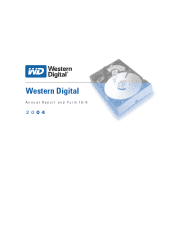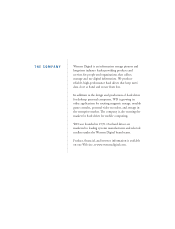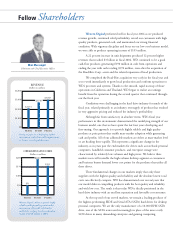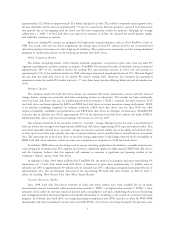Western Digital 2004 Annual Report Download - page 11
Download and view the complete annual report
Please find page 11 of the 2004 Western Digital annual report below. You can navigate through the pages in the report by either clicking on the pages listed below, or by using the keyword search tool below to find specific information within the annual report.Hard Disk Drive Products for Servers and External Storage. Western Digital's products for server and external
storage, such as network attached storage disk arrays (""NAS'') and storage area network disk arrays (""SAN'') currently
consist of 3.5-inch form factor products with capacities ranging from 36.7 GB to 250 GB and nominal rotation speeds of
7200 and 10,000 RPM. The Company's server and external storage products include the WD Raptor hard disk drive,
equipped with the SATA interface, and the WD Caviar RAID Edition hard disk drive, equipped with either the SATA
or EIDE interface.
Consumer Electronics Products. The Company oÅers design capabilities and hard disk drive technologies for
consumer applications. The Company currently oÅers hard disk drive products designed for use in consumer audio-video
applications such as PVRs and DVRs. It also oÅers products for the video game console market, and provides hard disk
drives for other consumer electronics products.
Technology and Product Development
Hard disk drives are used to record, store and retrieve digital data. Their performance attributes are currently better
than removable or Öoppy disks, optical hard disk drives and tapes, and they are more cost eÅective than semiconductor
technology. The primary measures of hard disk drive performance include:
""Storage capacity'' Ì the amount of data that can be stored on the hard disk drive Ì commonly expressed in
gigabytes. As deÑned in the hard disk drive industry, a gigabyte means one billion bytes. A byte is a digital
character, typically comprised of eight bits. A bit is a binary digit, the smallest unit of information in a digital
system.
""Average seek time'' Ì the time needed to position the heads over a selected track on the disk surface Ì
commonly expressed in milliseconds.
""Internal data transfer rate'' Ì the sustained rate at which data is transferred to and from the disk Ì
commonly expressed in megabits per second. One megabit is equal to one million bits.
""Spindle rotational speed'' Ì the nominal rotational speed of the disks inside the hard disk drive Ì
commonly expressed in RPMs, revolutions per minute or latency. While the reference to spindle rotational speeds of
5400, 7200 and 10,000 RPMs is commonly used, in some cases these speeds are approximations.
""Acoustics'' Ì the sound intensity that is emitted while the hard disk drive is operating Ì commonly
expressed in decibels.
All of the Company's hard disk drive products employ similar technology. The main components of the hard disk
drive are the head disk assembly and the printed circuit board. The head disk assembly includes the head, media
(disks), head positioning mechanism (actuator) and spin motor. These components are contained in a hard base plate
protective package in a contamination-controlled environment. The printed circuit board includes both standard and
custom integrated circuits, an interface connector to the host computer and a power connector.
The head disk assembly is comprised of one or more disks positioned around a spindle hub that rotates the disks by
a spin motor. Disks are made of a smooth substrate to which a thin coating of magnetic materials is applied. Each disk
has a head suspended directly above it, which can read data from or write data to the spinning disk.
The integrated circuits on the printed circuit board typically include a drive interface and a controller. The drive
interface receives instructions from the computer, while the controller directs the Öow of data to or from the disks and
controls the heads. The location of data on each disk is logically maintained in concentric tracks that are divided into
sectors. The computer sends instructions to the controller to read data from or write data to the disks based on track and
sector locations. Guided by instructions from the controller, the head stack assembly is pivoted and swung across the disk
by a head actuator or motor until it reaches the selected track of a disk, where the data is recorded or retrieved.
Industry standard interfaces are utilized to allow the hard disk drive to communicate with the computer. Currently,
the primary interface for desktop PCs is EIDE, and the primary interface for enterprise systems is SCSI. As computer
performance continues to improve, the hard disk drive will need to deliver information faster than these interfaces can
handle. The Company believes that the desktop PC industry plans to transition to higher speed interfaces, such as SATA,
to handle the higher data transfer rates. The Company currently oÅers its WD Caviar Special Edition SATA hard disk
6
























